Whether you’re a new coach or a seasoned pro, it’s essential to have a structured and effective training program to reach your goals. One popular and effective approach is zone-based training, which involves dividing swim training into intensity zones, each with a specific physiological adaptation target in mind.
Zone-based training provides a systematic way to train and monitor progress. By varying training intensity and targeting different energy systems, you can optimize performance, avoid injury and prevent overtraining.
In this blog, we'll dive into the key concepts and benefits of zone-based training. We'll explain how to divide training intensity into specific zones and outline the various goals for each zone. We'll also explore how to monitor progress and adjust your training program accordingly.
Finally, we'll highlight the latest advances in zone-based training, including polarized training and AI-driven critical swim speed. So, without further ado, let’s dive into everything you need to know about zone training in swimming.
What are the benefits of zone-based training?
Zone training is not a new concept for swim coaches. It has been around for a while, and depending on what part of the world you’re coaching in, the models vary anywhere from three and up to seven zones. No matter the model, zone-based training in swimming offers numerous benefits, including:
- Improved aerobic capacity: Zone-based training helps swimmers increase their aerobic fitness by working at different intensities for varying durations. This type of training helps to develop the swimmer's cardiovascular and respiratory systems, which can improve their endurance and ability to maintain a steady race pace.
- Increased speed: Swimmers can improve their speed by regularly training at high-intensity zones, which challenges their anaerobic system and helps them produce more power.
- Reduced risk of injury: By monitoring the swimmer's training intensity and ensuring they don't overtrain, coaches can help reduce the risk of injury. Overtraining can lead to fatigue, muscle soreness, and increased susceptibility to injury and illness.
- Individualized training: Zone-based training allows coaches to personalize training programs for each swimmer based on their goals, fitness level, and heart rate or perceived exertion. This helps swimmers work on weak areas and progress at their own pace.
- Improved recovery: Zone-based training also incorporates low-intensity zones, allowing swimmers to recover between high-intensity workouts. This helps prevent burnout and ensures swimmers give their bodies enough time to rest and recover.
- Increased motivation: Seeing progress can be a significant motivator. By training in different zones, swimmers can track their progress and see improvements in their performance, which can help keep them motivated to continue training hard.
How to use zone based-training to distribute intensity in your swim program?
To do this right, you’ll need to:
- Determine your zones
- Prepare your plan
- Monitor your swimmers' intensity
- Evaluate your swimmers' progress
Determine Your Zones
To create a zone-based training program, you need to determine the duration of exercise stress and the intensity. The duration is pretty straightforward, and it refers to how much time (or distance) you spend in a stress state. While intensity can be measured using many different methods like energy systems, heart rate, lactate threshold, rating of perceived exertion and critical swim speed.
The challenge with most of these methods is that they either use generalized mathematical equations like the age-adjusted method used in heart rate zones or require test sets and lactate testing to determine the threshold. This, in turn, means you'll need to invest time, expertise and resources to determine your swimmer’s training zones.
At TritonWear, we use a 5-zone model, based on the swimmer’s AI-driven Critical Swim Speed, making zones highly personalized for each athlete. What’s more, is that they don’t require tests or any time on your end. AI-driven CSS relies on machine learning algorithms to estimate the swimmer’s critical swim speed and then automatically divides training into specific zones.
Let’s take a look at the TritonWear Zones and how they map out based on CSS.
- Zone 1: Warm-up/Recovery. This zone is for a gentle warm-up or cool-down. It promotes recovery and prepares the body for more intense training.
- Zone 2: Aerobic Endurance. This zone is where most swimming occurs. It improves endurance, increases cardiovascular fitness, and burns fat.
- Zone 3: Threshold up to Critical Swim Speed. This zone hits an optimal intensity for the development of aerobic capacity and is also known as the Maximal Lactate Steady State where Lactate production = Lactate removal. This is considered the aerobic threshold or the highest intensity that can be sustained aerobically.
- Zone 4: Critical Swim Speed up to VO2 Max. This zone is referred to as the anaerobic threshold or lactate threshold, where your body utilizes both aerobic and anaerobic energy systems to produce energy.
- Zone 5: Lactate production & tolerance. This type of training includes Race Pace training and enhances the rate of glycolytic energy production. It is associated with the anaerobic energy system, meaning lactate production increases as exercise intensity rises, particularly when oxygen availability is limited.
%20(1).png?width=800&height=2000&name=TritonWear%20Zones%20(Infographic)%20(1).png)
* Critical Swim Speed refers to velocity not pace (time).
>>> Learn everything you need about Critical Swim Speed Training
Prepare Your Plan
How to organize and distribute exercise intensity in your periodized swimming plan?
Periodization is an approach to training that involves dividing the training year into smaller periods or cycles, with each cycle targeting specific aspects of fitness or performance.
/Winning%20Training%20plan%20Blog.png?width=600&height=200&name=Winning%20Training%20plan%20Blog.png)
Here are some general guidelines for organizing and distributing exercise intensity in your periodized swimming plan:
- Establish your goals: Before designing your plan, you should establish your goals and priorities for the upcoming training year. This will guide you in choosing the appropriate training cycles and workout intensities to achieve your desired outcomes.
- Create a macrocycle: The macrocycle is the longest period of training (usually up to a year), and includes several mesocycles (shorter training periods) that target specific aspects of fitness or performance. Within the macrocycle, you should include both high-intensity and low-intensity training periods to achieve a balanced overall training load.
- Include recovery periods: Recovery is an essential component of training, as it allows the body to adapt to exercise stress and improve performance. You should include recovery periods throughout your periodized plan, such as rest days or lighter training weeks, to prevent overtraining and optimize performance gains.
- Use the principle of progressive overload: Progressive overload involves gradually increasing training volume and intensity over time to challenge the body and promote adaptation. You should adjust training intensity and duration gradually throughout your plan to ensure that you are continually challenging your swimmers and making progress.
- Alternate training intensities: To ensure a well-rounded training program, alternate between high-intensity and low-intensity training periods within the macrocycle. This can include focussing more on power, speed, and strength in some mesocycles, while others could target endurance and recovery.
Overall, organizing and distributing exercise intensity in a well-structured, periodized swimming plan requires careful attention to individualized goals, events, progression, recovery, and adaptation.
Choosing the intensity distribution method that works best for you.
You’re all set; you have your goals and your plan but how do you distribute intensity through each cycle? Don’t sweat. We looked at the research and found that there are several different methods of training intensity distribution for improving swimming performance.
Here are some of the most commonly studied methods for you to choose from:
- Polarized training: In polarized training, the majority of training is done at low-intensity levels (e.g., 60-80% of maximum heart rate), with a smaller percentage of training done at high-intensity levels (e.g., 90% or greater of maximum heart rate) and only a small amount of moderate-intensity training.
- Threshold training: Threshold training involves focusing on training at intensities near the athlete's lactate threshold (the point where lactate begins to accumulate in the blood). This typically involves training at moderate-to-high intensity levels (e.g., 80-90% of maximum heart rate) for extended periods of time.
- High-intensity interval training (HIIT): In HIIT, athletes alternate between periods of all-out, maximal effort and periods of rest or lower-intensity recovery. This type of training can improve both anaerobic and aerobic fitness.
- Pyramidal training: As a comparison to the more structured training intensity distribution methods, pyramidal training is a method that has been used for years in swimming. It usually involves high volumes of low-to-moderate intensity training, with occasional high-intensity training sessions.
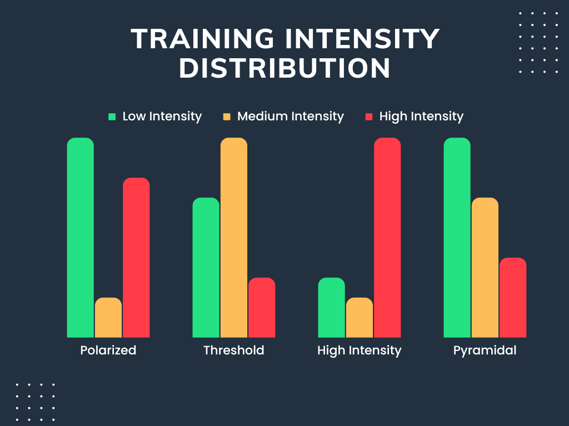
Overall, the optimal training intensity distribution may differ depending on the athlete's goals, training experience, and individual physiology. Some coaches like to combine different methods at different points in their cycle.
Monitor Your Swimmers’ Intensity
You have determined your swimmers' zones, decided which intensity distribution method you’ll use and prepared your overarching plan. Now, how do you monitor your swimmers’ intensity and ensure they put in the required effort in each workout?
To achieve the best results, you must understand how to measure intensity during workouts. One option is to use a heart rate monitor, which will allow you to determine your swimmer’s heart rate in real-time throughout the training session. To do this, TritonWear integrates with Polar Verity sense.
However, we found that Heart Rate is best used within a broader context of data. What some coaches may not know is that heart rate ranges for each zone can vary significantly from swimmer to swimmer. While it’s common to use standard heart rate zones or percentages of maximum heart rate to define each zone, swimmers can have different heart rate responses even when swimming in the same set. This is because many factors affect heart rate, such as age, gender, fitness level, hydration status, and more.
To overcome this challenge, coaches can personalize each athlete's training zones based on their individual performance data. As mentioned further up in this article, TritonWear does this with an AI-driven CSS estimation for each swimmer and each stroke. This type of personalization in training zones enables coaches to ensure that each swimmer is training at the appropriate intensity level for their unique physiology, leading to more effective and efficient training programs.
TritonWear Live Skills, Heart Rate & Training Zones
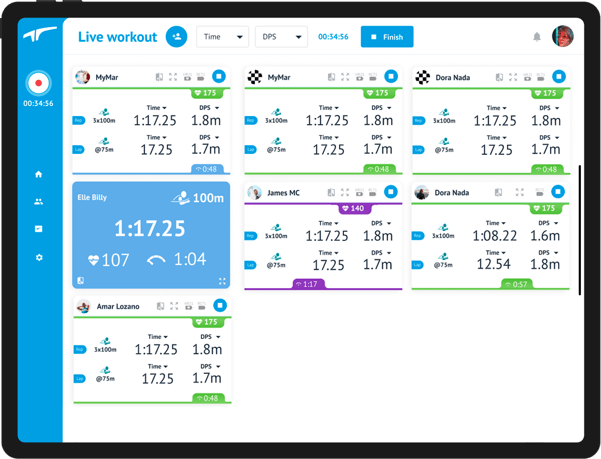
Evaluate Your Swimmers' Progress
Finally, as with any training program, it is essential to monitor your swimmers' progress regularly. It is recommended to use performance metrics to track your workout achievements and assess progress in each zone. TritonWear Intensity tracking allows you to make informed decisions and adjust training sessions. The historical data gathered from each workout helps coaches to evaluate time spent in each zone and the balance between aerobic and anaerobic work. This valuable feedback allows you to make informed design changes in your training to maximize athlete performance.
TritonWear Intesity
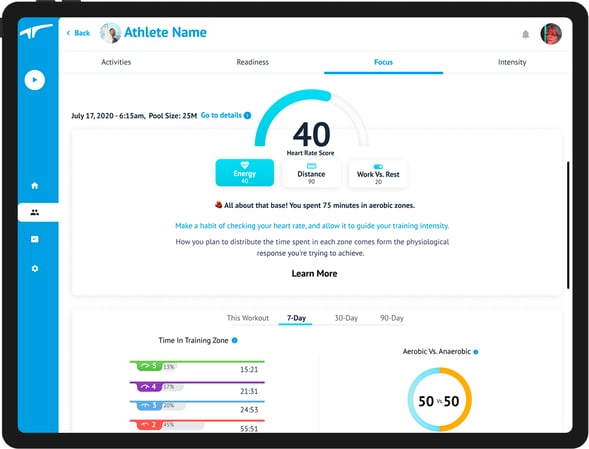
Key takeaways
In conclusion, zone-based training provides you with an effective way to incorporate different intensities and focus areas into your swim training. By dividing training into different training zones, you can tailor workouts to suit your athletes’ individual needs and goals. This approach allows you to focus on specific training areas, such as endurance, strength, or speed, and optimize their training accordingly.
Whether you are a beginner or an experienced coach, zone-based training is a valuable tool for achieving your team goals and improving your athletes' overall fitness. With proper planning and execution, this training method can help your swimmers enhance their performance and reach their full potential in the pool.



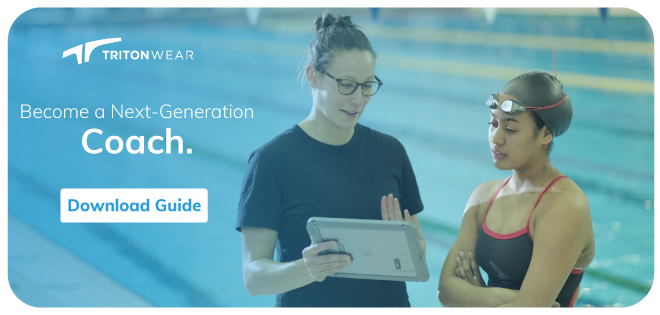

.png)
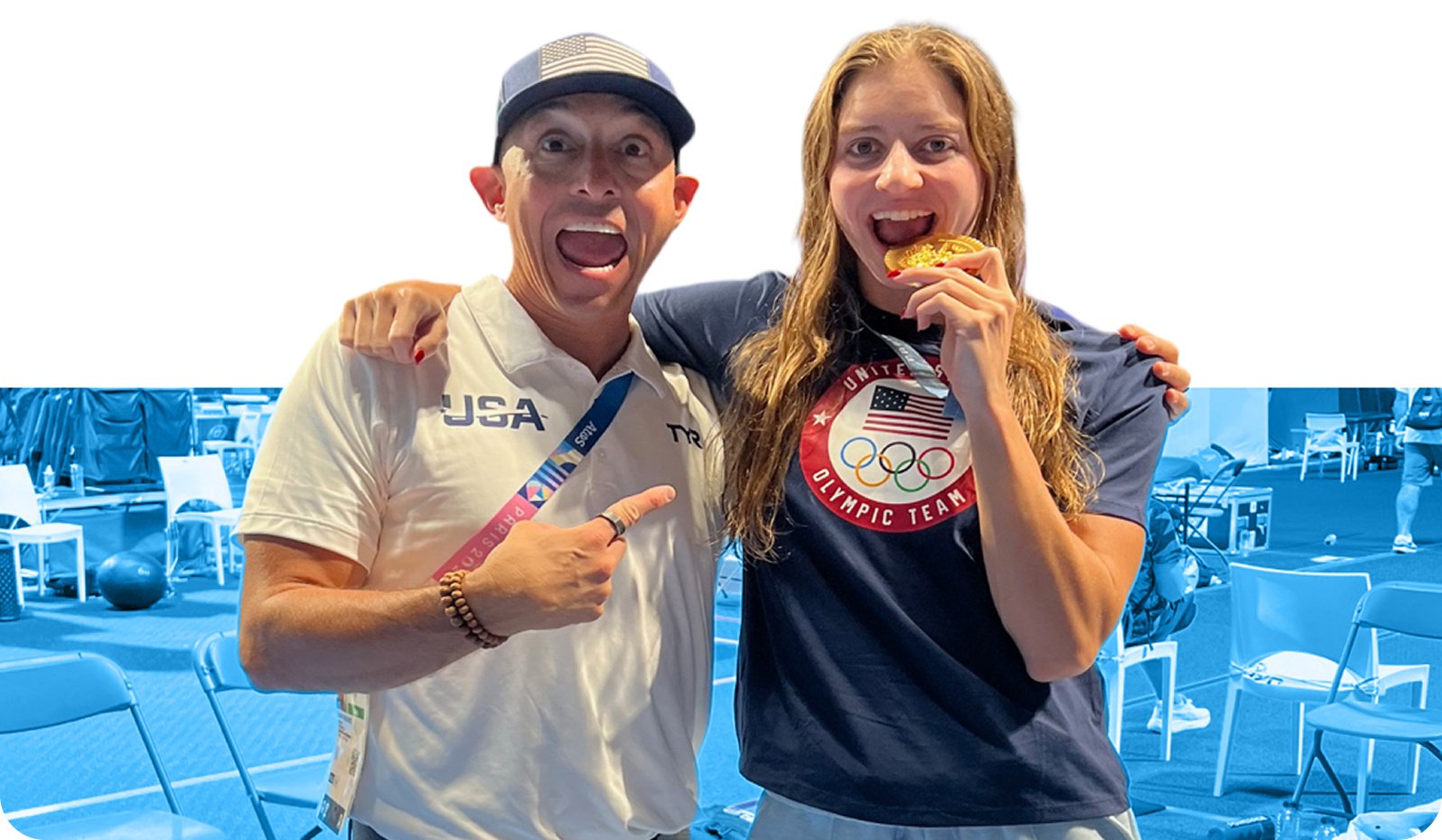
.png)